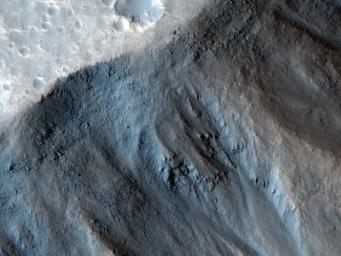
|
(Almost) Silent Rolling Stones in Kasei Valles
- Click the image above for a larger view
- Full-Res JPEG (2560 x 1920) (952.1 kB)
- Full-Res TIFF (2560 x 1920) (14.8 MB)
Caption:
This observation from NASA's Mars Reconnaissance Orbiter (MRO) shows the very steep side of a plateau, part of the northern limit of the Kasei Valles system, which is one of the largest outflow channel systems on Mars.
The difference in elevation here between the mostly flat channel's floor (bottom right) and the top of the plateau (top left) is over 1,300 meters (0.8 miles), comparable in height to the Grand Canyon walls.
The Kasei Valles system is much wider than the Grand Canyon, though, getting to be in places 500 kilometers (300 miles) wide. (The Grand Canyon's maximum width is 30 kilometers, or 18 miles).
This subimage shows numerous paths with the appearance of dotted lines, criss-crossing the steep side of the plateau. The carving agents can be found at the end of some of these paths: rocky blocks such as the ones in this subset, up to 2 meters (2.2 yards) across (4 meters or 4.4 yards across elsewhere in the image).
Some of these blocks traveled downhill several hundred meters (yards) as they rolled and bounced leaving behind a trail of indentations or poke marks in the surface's fine-grained, light-toned soils. The raised borders in some of these poke marks indicate they are relatively recent features, unaffected by wind erosion, or that this soil has cohesive properties, such as if it was cemented.
The sound of these blocks falling did not travel very far, though. According to computer simulations sound in Mars travels only 1.5 percent the distance it would travel on Earth. (No Martian sound has ever been recorded.) Hence, the same sound which would travel one kilometer (0.6 miles) on Earth would travel only 15 meters (16 yards) on Mars. This is due to the lower Martian atmospheric pressure, which is approximately one percent of that of Earth.
Originally released on July 7, 2010
Background Info:
The University of Arizona, Tucson, operates the HiRISE camera, which was built by Ball Aerospace & Technologies Corp., Boulder, Colo. NASA's Jet Propulsion Laboratory, a division of the California Institute of Technology, Pasadena, manages the Mars Reconnaissance Orbiter for the NASA Science Mission Directorate, Washington. Lockheed Martin Space Systems, Denver, is the spacecraft development and integration contractor for the project and built the spacecraft.
Cataloging Keywords:
| Name | Value | Additional Values |
|---|---|---|
| Target | Mars | |
| System | ||
| Target Type | Planet | |
| Mission | Mars Reconnaissance Orbiter (MRO) | |
| Instrument Host | Mars Reconnaissance Orbiter | |
| Host Type | Orbiter | |
| Instrument | High Resolution Imaging Science Experiment (HiRISE) | |
| Detector | ||
| Extra Keywords | Atmosphere, Color | |
| Acquisition Date | ||
| Release Date | 2010-07-13 | |
| Date in Caption | 2010-07-07 | |
| Image Credit | NASA/JPL-Caltech/University of Arizona | |
| Source | photojournal.jpl.nasa.gov/catalog/PIA13265 | |
| Identifier | PIA13265 | |
